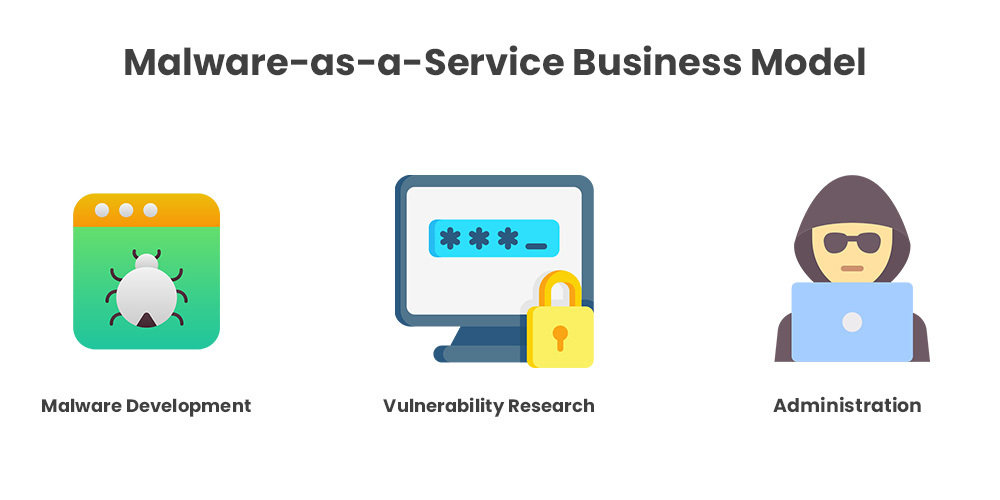 Blog's Page
Blog's Page

In The Evolving World Of Cyber Threats, Traditional Malware Is No Longer Just A Product Of Skilled Hackers Writing Code In Dark Rooms. Today, Cybercrime Has Become A Full-fledged Business, And Malware-as-a-Service (MaaS) Is One Of Its Most Dangerous And Fast-growing Branches. MaaS Platforms Provide Cybercriminals With Ready-made, Easy-to-use Tools To Launch Attacks — Even Without Technical Knowledge.
In This Article, We’ll Explore What MaaS Is, How It Works, Examples, Its Impact On Cybersecurity, And How Businesses And Individuals Can Defend Themselves.
Malware-as-a-Service (MaaS) Is A Business Model In The Cybercrime Underworld Where Cybercriminals rent Or Sell Access To Malware Tools And Platforms To Other Attackers. Think Of It As A Criminal Version Of Software-as-a-Service (SaaS), But Instead Of Productivity Tools, It Offers Ransomware, Spyware, Keyloggers, Botnets, And More.
Just Like Legal SaaS Products, MaaS Platforms Often Include:
User-friendly Dashboards
Technical Support (via Forums Or Encrypted Chat)
Subscription Or One-time Payment Options
Updates And New Features
These Platforms Are Usually Hosted On dark Web Marketplaces, And They Allow Even Novice Attackers — With Zero Coding Skills — To Launch Highly Effective Cyberattacks.
The MaaS Model Follows A Structured System, Often Mimicking Legitimate Software Businesses. Here's A Breakdown Of How It Operates:
These Are The Creators Of Malicious Code. They Develop Trojans, Ransomware, RATs, Or Stealers.
The Malware Is Hosted On Dark Web Marketplaces. Buyers Can Browse Various Tools And Packages, View Reviews, And Even Get Free Trials.
Pricing Is Flexible:
Monthly Subscriptions
Pay-per-install (PPI)
Affiliate Commissions (common In Ransomware)
Custom Builds For Advanced Attackers
Surprisingly Professional — Some MaaS Providers Offer FAQs, Video Tutorials, And 24/7 Support Via Encrypted Messaging Apps.
Buyers Use The Malware For Phishing, Remote Access, Data Theft, Or Launching Ransomware Campaigns. They Often Combine MaaS With phishing Kits, initial Access Brokers (IABs), Or Botnets To Scale Attacks.
MaaS Includes A Variety Of Malware, Each With Different Use Cases:
Attackers Rent Ransomware To Encrypt Victims’ Files And Demand Ransom. Examples Include LockBit, DarkSide, And Conti.
Enable Full Control Over The Victim’s System. Example: CrimsonRAT, RomCom, njRAT.
Capture Keystrokes, Credentials, And Financial Data. Example: Vidar, RedLine, Racoon Stealer.
Create Zombie Networks Of Infected Machines For DDoS, Spam, Or Crypto Mining. Example: Mirai, QakBot Clones.
Dridex Banking Trojan Evolved Into A MaaS Platform That Enabled Widespread Financial Fraud Globally.
Initially A Banking Trojan, Emotet Evolved Into A MaaS Loader For Ransomware And Info-stealers.
Both Offer Ransomware-as-a-Service, Giving Affiliates Access To Encryption Tools And Data Leak Sites.
A Popular MaaS Tool Used For Espionage, Credential Theft, And Logging Keystrokes.
MaaS Lowers The Barrier Of Entry Into Cybercrime. It Empowers Low-skilled Attackers With Access To Powerful Malware Tools — And That Makes It Extremely Dangerous.
A Single Developer Can Sell Malware To Hundreds Or Thousands Of Customers.
Most Transactions Are Conducted Via cryptocurrency And Tor Networks, Making It Difficult To Trace.
MaaS Tools Are Regularly Updated To bypass Antivirus And evade Detection.
Attackers From Anywhere In The World Can Launch Attacks On Any Target — Individual, Business, Or Government.
Although MaaS-based Attacks Are Increasing, You Can Reduce The Risk By Adopting Layered Cybersecurity Measures:
Use AI-based Antivirus And EDR Solutions That Detect And Isolate Suspicious Activity.
Conduct regular Cybersecurity Awareness Training To Identify Phishing, Suspicious Downloads, And Social Engineering.
Keep All Systems, Software, And Plugins up To Date To Patch Vulnerabilities.
Restrict Internal Access, Use MFA, And Continuously Verify User Activity.
Maintain regular Backups And Test disaster Recovery Procedures Frequently.
Monitor For Stolen Credentials Or Internal Data Sold Or Leaked On Dark Web Forums.
Cybersecurity Experts Warn That MaaS Will Continue To Evolve With:
AI-powered Phishing Kits
Deepfake And Voice Impersonation Malware
Cloud-focused MaaS Payloads
Cross-platform (Windows, Linux, Mac, Android) Malware
As Cybercrime Continues To Become commercialized, Organizations Must treat Cybersecurity As A Continuous Investment, Not A One-time Fix.
Malware-as-a-Service (MaaS) Represents A Chilling Advancement In The Cybercrime World. By Democratizing Access To Powerful Malware, It Allows A Wider Group Of Attackers To Launch Sophisticated Campaigns — Making It One Of The biggest Cybersecurity Threats In 2025 And Beyond.
From Phishing Kits To Ransomware Payloads, MaaS Lowers The Barrier Of Entry For Cybercriminals While Raising The Stakes For Businesses And Individuals. Staying Protected Requires A Proactive, Layered Defense Strategy, Regular Education, And Investment In Cutting-edge Tools.
Malware-as-a-Service, MaaS In Cybersecurity, Ransomware-as-a-Service, MaaS Examples, How MaaS Works, Dark Web Malware Sales, MaaS Protection Tips